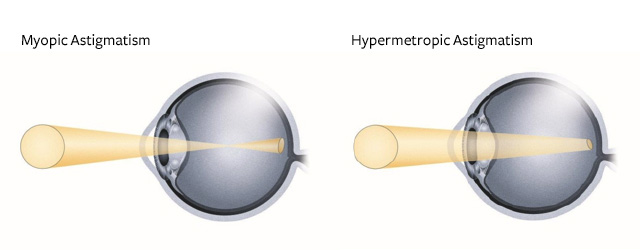Astigmatism
Generally the eye collects light to a single focus, but with astigmatism there may be two (or more) focal points. Most commonly this is due to two (or more) curvatures in the cornea, sometimes it is because of the lens, and occasionally because of the shape of the posterior segment of the eye.
With astigmatism the corneal shape is not round like a Soccer ball, the shape with is more like an Aussie Rules or Rugby football, where there is a flat curve and a steeper curve. These curvatures bend light differently depending on the corneal location it passes through. The steep curve brings light to a focus further from the retina than the focus from the flat curve. An irregularly curved cornea may produce multiple foci, and this may be produced by conditions such as Keratoconus or corneal scarring.
Most folk have some astigmatism in addition to another refractive error such as myopia or hypermetropia. If the astigmatism is less than 1.00 to 1.50 dioptres, it may not be noticed because it does not degrade the vision much. Astigmatism is often more prominent at night where it makes a point of light look streaked, flaring it in one direction.
It is possible to correct up to around 3.00 dioptres with laser refractive surgery, corneal relaxing incisions also help to reduce the astigmatism. Toric intra-ocular lenses that correct for astigmatism are now available and are very useful when considering lens implants.
Glasses are the simplest option to correct astigmatism and have the least complications. Contact lenses are another suitable alternative, however for a larger correction, a rigid gas permeable contact lens may be the best solution. We do not recommend that people routinely sleep in contact lenses long term, as there is a greater risk for infection.




 New Vision Centre
New Vision Centre